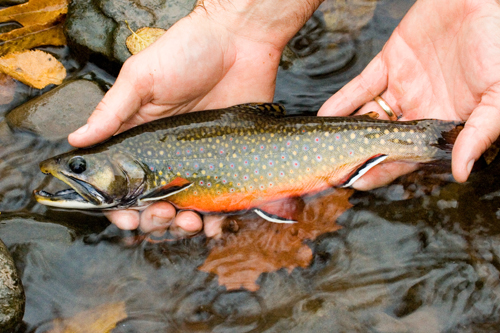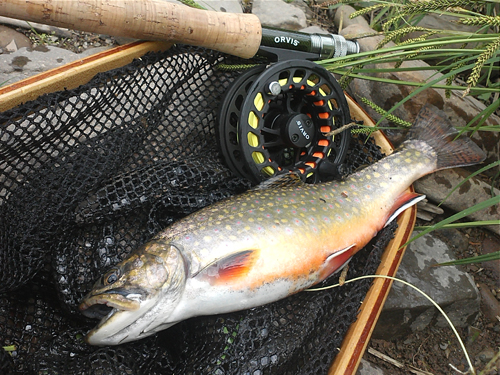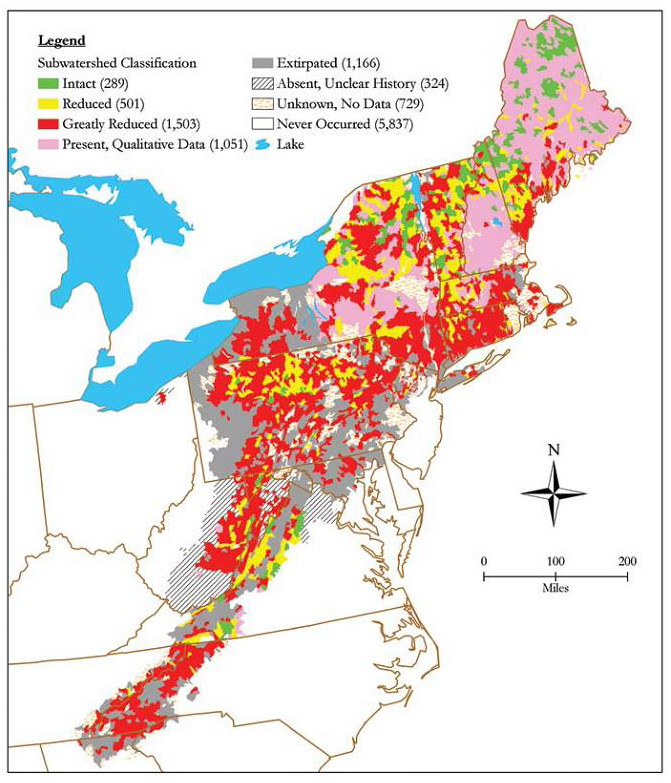Brook Trout in Maryland
Why brook trout?
 Brook trout, widely esteemed as one of the most beautifully colored of all freshwater fish, have a rich history in Maryland. Before European settlement brook trout could be found in Maryland streams and rivers from the northern Chesapeake Bay to the western mountains. The fish were enmeshed in Native American culture and lore, revered by the Seneca Indians and the Six Nations tribes as a gift from their spirit leader Manitou. Angling for brook trout was a popular pastime for early settlers and continues to be popular among anglers today. The story of the world record brook trout caught by Daniel Webster in 1828 in a New York river is one of the most famous fishing stories of all time. Webster was a longtime New York State Senator, known for his passion for brook trout fishing -- and for rum! After several years of pursuing a giant brook trout in a Long Island River, Webster finally got his chance. Unfortunately, the huge trout was spotted while Webster was attending church. Not only did Webster slide out the back door, but so did the rest of the congregation, followed by the minister (another avid brookie angler) who managed to finish his sermon while walking with the congregation down to the river! Webster caught the huge trout on an artificial fly, and the 14-pound, 8-ounce fish remains the largest angler-caught brook trout to this day! While human impacts over the past two centuries have resulted in significant population declines, recent scientific research combined with growing concern from recreational fishing groups has invigorated efforts to assist this spectacular species.
Brook trout, widely esteemed as one of the most beautifully colored of all freshwater fish, have a rich history in Maryland. Before European settlement brook trout could be found in Maryland streams and rivers from the northern Chesapeake Bay to the western mountains. The fish were enmeshed in Native American culture and lore, revered by the Seneca Indians and the Six Nations tribes as a gift from their spirit leader Manitou. Angling for brook trout was a popular pastime for early settlers and continues to be popular among anglers today. The story of the world record brook trout caught by Daniel Webster in 1828 in a New York river is one of the most famous fishing stories of all time. Webster was a longtime New York State Senator, known for his passion for brook trout fishing -- and for rum! After several years of pursuing a giant brook trout in a Long Island River, Webster finally got his chance. Unfortunately, the huge trout was spotted while Webster was attending church. Not only did Webster slide out the back door, but so did the rest of the congregation, followed by the minister (another avid brookie angler) who managed to finish his sermon while walking with the congregation down to the river! Webster caught the huge trout on an artificial fly, and the 14-pound, 8-ounce fish remains the largest angler-caught brook trout to this day! While human impacts over the past two centuries have resulted in significant population declines, recent scientific research combined with growing concern from recreational fishing groups has invigorated efforts to assist this spectacular species.
When is a trout not a trout?
Maryland's only native salmonid, Salvelinus fontinalis, has a vividly speckled back, bright orange belly and blazing black and white striping on the edges of its ventral (belly or abdominal) fins. Like the lake and bull trout however, this brilliant swimmer is actually a member of a group of fish known as charr — the English name given to all members of this genus. Brown and rainbow trout — two exotic trout species that are stocked and managed for recreational fishing by the Maryland Department of Natural Resources — are historically considered true members of the trout group.
An indicator species
Brook trout are highly valuable to Maryland for their recreational, economic, cultural and biological values. According to a recent study in Pennsylvania, which has a similar wild brook trout fishery, wild trout anglers spent an average of $45 per day when fishing, contributing more than $2 million annually to local economies through direct and indirect  expenses from fishing trips. Because of their habitat and survival requirements, brook trout are typically found in the state's more pristine and remote areas. Biologically they are considered an indicator species, representative of a whole suite of unique aquatic and terrestrial organisms that occupy and share habitat. Their loss from any given area indicates negative changes to the habitat and overall ecosystem. The decline of brook trout populations in Maryland has been drastic. They have been eliminated from 62 percent of their historic habitat, and the vast majority of remaining populations are considered greatly reduced, occupying less than 10 percent of their historic range. With Maryland's human population expected to continue to grow over the next several decades, the future of brook trout in Maryland has reached a critical juncture.
expenses from fishing trips. Because of their habitat and survival requirements, brook trout are typically found in the state's more pristine and remote areas. Biologically they are considered an indicator species, representative of a whole suite of unique aquatic and terrestrial organisms that occupy and share habitat. Their loss from any given area indicates negative changes to the habitat and overall ecosystem. The decline of brook trout populations in Maryland has been drastic. They have been eliminated from 62 percent of their historic habitat, and the vast majority of remaining populations are considered greatly reduced, occupying less than 10 percent of their historic range. With Maryland's human population expected to continue to grow over the next several decades, the future of brook trout in Maryland has reached a critical juncture.
Human vs. fish
 Brook trout populations have suffered not just in Maryland but throughout their native range across the eastern United States. The reasons for these declines are many and vary by state, but the most common thread is that brook trout populations are incredibly sensitive to human perturbations within their watersheds. These impacts include urbanization, agriculture, forestry, exotic species, acid rain and acid mine drainage. In Maryland, our brook trout populations have suffered at one time or another from all these impacts. However, recent research and economic evaluations by scientists have combined with growing concern from recreational fishing groups to draw attention to their plight. The sensitivity of brook trout populations to human land use is clearly illustrated by two scientific analyses. The Department's Maryland Biological Stream Survey plotted the percentage of ground area covered by impervious surface — land covered by pavement and roofs that prevent water from being absorbed into the ground -- in a watershed versus the presence of brook trout populations. The survey found that the vast majority of populations occur only in watersheds where less than 1.5 percent of the ground area is impenetrable. In a similar study, researchers with the United States Forest Service looked at human land-use patterns such as development, farming and road building within a subwatershed and found that once land-use exceeds 18 percent, brook trout will not survive. Put simply, the more people and associated impacts there are in a watershed, the less likely brook trout are to survive. These conclusions are especially sobering considering the booming population trends in Maryland.
Brook trout populations have suffered not just in Maryland but throughout their native range across the eastern United States. The reasons for these declines are many and vary by state, but the most common thread is that brook trout populations are incredibly sensitive to human perturbations within their watersheds. These impacts include urbanization, agriculture, forestry, exotic species, acid rain and acid mine drainage. In Maryland, our brook trout populations have suffered at one time or another from all these impacts. However, recent research and economic evaluations by scientists have combined with growing concern from recreational fishing groups to draw attention to their plight. The sensitivity of brook trout populations to human land use is clearly illustrated by two scientific analyses. The Department's Maryland Biological Stream Survey plotted the percentage of ground area covered by impervious surface — land covered by pavement and roofs that prevent water from being absorbed into the ground -- in a watershed versus the presence of brook trout populations. The survey found that the vast majority of populations occur only in watersheds where less than 1.5 percent of the ground area is impenetrable. In a similar study, researchers with the United States Forest Service looked at human land-use patterns such as development, farming and road building within a subwatershed and found that once land-use exceeds 18 percent, brook trout will not survive. Put simply, the more people and associated impacts there are in a watershed, the less likely brook trout are to survive. These conclusions are especially sobering considering the booming population trends in Maryland.
Growing Support
 Fortunately, there is a strong and growing cadre of brook trout supporters including state fisheries agencies, federal natural resource agencies, academic researchers and a variety of angler and conservation organizations. At a 2004 a meeting in Shepherdstown, West Virginia, stakeholders interested in restoring and protecting brook trout shared ideas, visions and concerns. The group created the Eastern Brook Trout Joint Venture, a multi-state consortium focused on conserving and restoring these populations. During this same period, the Department's Freshwater Fisheries Management Division was initiating development of a Brook Trout Fisheries Management Plan. The plan focuses on identifying the problems facing Maryland populations and developing management recommendations to guide the conservation and restoration of the resource. The goal of the plan is "to restore and maintain healthy brook trout populations in Maryland's freshwater streams and provide long-term social and economic benefits from a recreational fishery." The plan was completed and implemented in 2006 and continues to be used and updated to help direct Brook Trout management statewide. Since the beginning of these two efforts, momentum and support has been building steadily among the many partners of the Eastern Brook Trout Joint Venture and Maryland's angling and conservation community. Through their work and that of the larger National Fish Habitat Initiative, funding to initiate brook trout restoration projects has become available. Maryland Freshwater Fisheries has applied for some of this funding as part of a restoration project in Aaron's Run, Garrett County, where brook trout have been extirpated due to acid mine drainage. Trout Unlimited, a national partner in the Eastern Brook Trout Joint Venture, has created a Back the Brookie campaign to raise awareness and encourage conservation of native populations. Even more exciting is the formation of several brook trout watershed advocacy groups. Conserving and restoring Maryland's native brook trout populations are major challenges for resource managers and their partners. It must also be a priority, if we are to ensure this longtime Maryland resource has a future here. These efforts can only succeed with the help of partners and advocacy groups.
Fortunately, there is a strong and growing cadre of brook trout supporters including state fisheries agencies, federal natural resource agencies, academic researchers and a variety of angler and conservation organizations. At a 2004 a meeting in Shepherdstown, West Virginia, stakeholders interested in restoring and protecting brook trout shared ideas, visions and concerns. The group created the Eastern Brook Trout Joint Venture, a multi-state consortium focused on conserving and restoring these populations. During this same period, the Department's Freshwater Fisheries Management Division was initiating development of a Brook Trout Fisheries Management Plan. The plan focuses on identifying the problems facing Maryland populations and developing management recommendations to guide the conservation and restoration of the resource. The goal of the plan is "to restore and maintain healthy brook trout populations in Maryland's freshwater streams and provide long-term social and economic benefits from a recreational fishery." The plan was completed and implemented in 2006 and continues to be used and updated to help direct Brook Trout management statewide. Since the beginning of these two efforts, momentum and support has been building steadily among the many partners of the Eastern Brook Trout Joint Venture and Maryland's angling and conservation community. Through their work and that of the larger National Fish Habitat Initiative, funding to initiate brook trout restoration projects has become available. Maryland Freshwater Fisheries has applied for some of this funding as part of a restoration project in Aaron's Run, Garrett County, where brook trout have been extirpated due to acid mine drainage. Trout Unlimited, a national partner in the Eastern Brook Trout Joint Venture, has created a Back the Brookie campaign to raise awareness and encourage conservation of native populations. Even more exciting is the formation of several brook trout watershed advocacy groups. Conserving and restoring Maryland's native brook trout populations are major challenges for resource managers and their partners. It must also be a priority, if we are to ensure this longtime Maryland resource has a future here. These efforts can only succeed with the help of partners and advocacy groups.